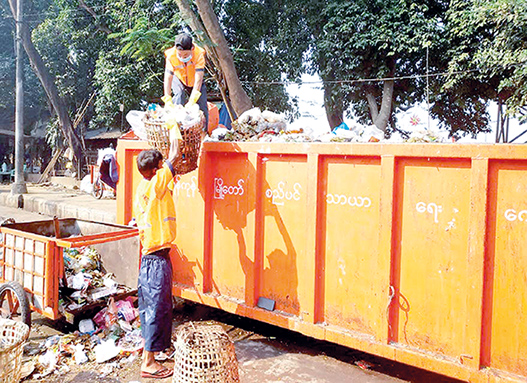By Bawgar Thway
Yangon is going to turn 1,000 tonnes out of the total waste that its households and people generate daily into energy, citing Yangon City Development Committee, adding that the waste-to-energy project is going to begin.
The reason to say exactly about the waste-to-energy project is that it came from the 15th regular meeting of Second Pyidaungsu Hluttaw held for the fourth day on 31 January during which reached an agreement.
It was also learnt that if Pyidaungsu Hluttaw approved the proposal, it could be started in May.
Individual’s rubbish disposal increase in amount
The waste-to-energy project is a must for Yangon. The time has come for Yangon to transform garbage into energy for the reason that the Yangonites generate from 2,300 to 2,500 tonnes of waste each day. If it is mentioned in detail, individual’s disposal of trash every day has increased in amount. Among the latest landfills in Yangon, Hteinbin is the largest with an area of about 290 acres.
It requires collaborative efforts
The waste generation of the Yangonites has been increasing day by day, month by month and year by year. Despite the fact that the relevant organizations and social ones raise awareness campaigns and launch education, lack of observance and contribution has risen obviously.
Essential project for Yangon
The accumulation of garbage in Hteinbin landfill has become larger, covering about 220 acres. About 70 acres of land are still left to be dumped in Hteinbin landfill. According to the calculation of the researchers, the whole Hteinbin landfill will be fully filled with the rubbish in the next four years, thereby resulting in a scarcity of land to damp the further waste in Yangon. For that reason it has become the essential project for Yangon.
The waste-turned-to energy project will be partnered with Poland government that will release Euro 50 million of official development assistance loans. The garbage has to be repaired, sanitized and destroyed, according to an official of the YCDC.
Generation of about 250 tonnes
The project will generate about 1,000 tonnes of rubbish per day. 30 tonnes of CNG, 40 tonnes of liquid carbon dioxide, 180 tonnes of RDF and 250 tonnes of natural humus will be regenerated from the waste.
Direct contact and sale of energy
Negotiations have been conducted to directly contact and sell the energy generated from the waste. The interest rate on the loans is very small. The interest rate on the loan is 0.1 % and loan repayment period is 62 years.
Hluttaw holds discussions on waste-to-energy project
Regarding the waste-to-energy project, Hluttaw held rounds of discussions. Dr. Tin Tin Win, Hluttaw representative representing constituency 5 of Bago Region said if the waste management is carried out in a systematic manner, recycled materials can be reclaimed and income can be generated from the waste. Good waste management ensures energy savings, thereby protecting global earth pollution. The project needs to bring benefits to the region and its people. Actually, rubbish has been dumped in Hteinbin landfill since 2011. With the increasing amount of the rubbish, the landfill has gradually become larger and larger. But, Hteinbin landfill was on fire as a result of lack of technological management in 2018, taking about two weeks. The ash coming from the landfill fire spread much of Yangon so some citizens were sent to the hospitals for undergoing medical treatment, also causing grave concern to the Yangonites.
The acts of improving or changing something
The fire of Hteinbin landfill was under control due to the concerted efforts of the firemen of Myanmar Fire Services Department. Lessons will have to be taken and reforms will have to be made, too.
The disposal of waste segregation is of importance
Regarding the disposal of waste segregation, Pyithu Hluttaw MP Daw Mya Mya Myo representing Kyauktan Township said the aim of supporting this project is not to face further possible danger of fire. I found out that the income from the project with the use of technical assistance by Poland will be sufficient enough to settle the loan from Poland.
With regard to the waste-to-energy project, the disposal of dry and wet waste is of importance. The Yangonites usually put all the wastes only into a single bag and it is discarded and they don’t classify the types of waste.
Generally, solid wastes are segregated publically into two: wet and dry.
Wet waste such as kitchen waste, left-over, flowers can be discarded safely tight with blue bags daily. Dry waste such as paper, cork, plastic, broken toys, pieces of metal, pieces of wire can be discarded safely tight with green bags weekly. At the beginning of the waste segregation program, both blue and green plastic bags are available, but later it is not easy to buy them. The writer himself went to the sanitation department of his township whenever it was an opportune time and asked to buy plastic bags, but in vain. He will never ask the department any more. The Yangonites are used to disposal of waste by black polyethylene plastic bag and it is a habitual action.
The municipal should pay attention to the sales and distribution of blue and green plastic bags to the public for ensuring that the people can discard the waste by segregating the solid waste into the dry and the wet.
Translated by Htut Htut (Twantay)


